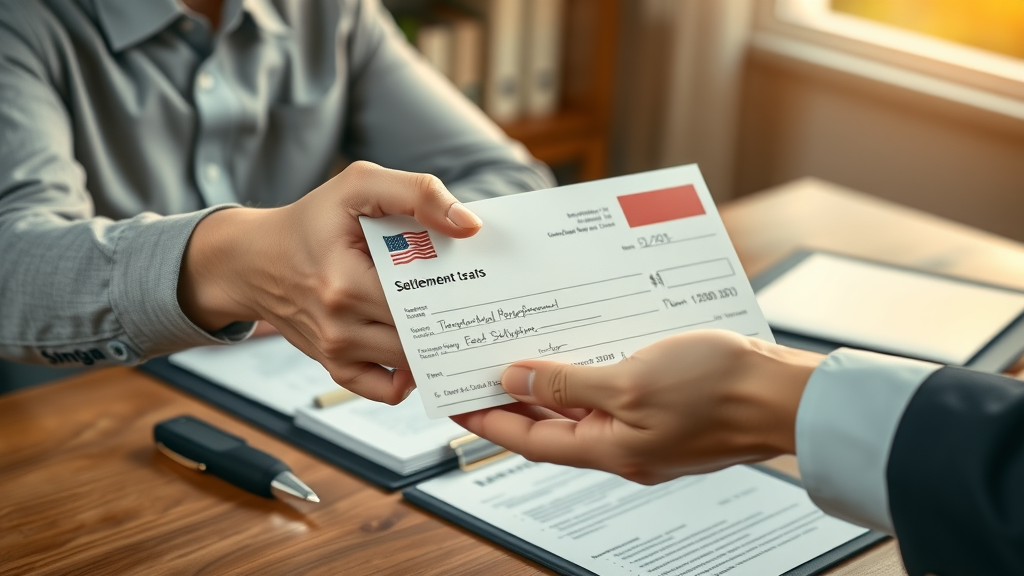Did you know: Over 90% of personal injury cases settle before ever reaching trial. If you’re navigating a personal injury lawsuit process for the first time, understanding the pivotal steps is crucial—not just for peace of mind, but to maximize your recovery. This guide demystifies the journey from injury to resolution, equipping you with practical knowledge and real-world examples so you can take every step with confidence.

Did You Know? Most Personal Injury Claims Settle Before Trial – Understanding the Personal Injury Lawsuit Process
The personal injury lawsuit process might seem daunting, but most personal injury claims never see the inside of a courtroom. In fact, around 95% of injury cases are resolved through settlement negotiations , ensuring accident victims receive compensation efficiently. This process is streamlined under personal injury law , enabling claimants—the injured party—to focus on recovery rather than protracted legal battles.
Personal injury law is unique because it is designed to protect the rights of those harmed by another’s negligence. The process involves specific steps, such as collecting evidence, negotiating with an insurance company , and adhering to strict filing deadlines. Crucially, understanding these steps can mean the difference between a denied claim and fair compensation. For instance, while many situations resolve with a simple demand letter, others may require litigation if the parties can’t agree on a fair outcome. Knowing where you are in the process at all times can help you—and your injury lawyer—make more informed decisions.
What Makes the Personal Injury Lawsuit Process Unique Under Personal Injury Law?
The personal injury lawsuit process operates differently from other civil cases because it relies heavily on concrete documentation—such as medical records, photos from the accident scene, and witness statements—to establish liability and damages. The claimant—the injured party—must present evidence that not only proves the fault of the opposing party but also demonstrates the full extent of the damage sustained. Detailed paperwork is a vital foundation, while deadlines governed by local injury laws can affect your ability to pursue a case.
Additionally, personal injury law places unique emphasis on timely medical treatment, which not only benefits your recovery but strengthens your case. Prompt medical care helps connect your injuries directly to the incident, while consistent documentation counters defense arguments that downplay the extent of your injuries. Personal injury cases typically include both physical and emotional damages, and your attorney will work diligently to ensure all such losses are fully represented throughout the process.
Legal representation under personal injury law is another key differentiator. Unlike criminal law, which is prosecuted by the state, injury cases are civil matters where the burden of proof rests on the injured party. Engaging an experienced personal injury attorney early ensures that every critical detail—from evidence preservation to negotiation strategy—is meticulously handled right from the start.
Overview: What You’ll Gain from This Personal Injury Lawsuit Process Guide
- Gain clarity on all major steps in the personal injury lawsuit process
- Learn where personal injury law protects claimants and the injured party
- Discover the important role of medical treatment, documentation, and legal counsel
- Understand timelines, negotiation stages, and settlement expectations for your injury case

Initiating the Personal Injury Lawsuit Process: First Steps for an Injury Claim
Taking the first steps in a personal injury lawsuit process can be overwhelming. Understanding what actions to take immediately after sustaining a personal injury significantly impacts your ability to secure a favorable outcome. The process begins well before filing any formal paperwork—starting with documenting the incident and seeking appropriate medical treatment to establish an official record.
Once you address urgent medical needs, it’s critical to consult a personal injury attorney who can help you evaluate the facts of your injury case. Most lawyers offer a free consultation to assess the strengths and weaknesses of your claim, determine liability, and explain how the law applies to your unique situation. This early evaluation sets the stage for gathering crucial evidence, estimating damages, and determining the right strategy for pursuing your injury claim—whether through negotiation or litigation.
Evaluating Your Personal Injury Case and Consulting a Personal Injury Attorney
- Key elements of a valid injury case
- How a personal injury attorney assesses claims
- Importance of consulting injury lawyers early
A successful personal injury case begins with a solid understanding of what makes a claim valid under injury law . Essential elements include proving that the other party owed you a duty of care, demonstrating a breach of that duty (usually through negligence), and establishing that this breach directly caused your injuries. A personal injury attorney will analyze all documentation from your accident—such as medical records , accident scene photos, and police reports—to determine whether your claim is legally sound. During this initial consultation, your lawyer also considers the extent of your injuries, lost wages, and other damages, forming a case valuation.
"Most personal injury cases hinge on timely consultation with an experienced personal injury attorney."
Consulting an injury lawyer early is vital, as they can immediately step in to protect your interests by handling communications with insurance adjusters, ensuring vital evidence is preserved, and guiding you away from common pitfalls. Early legal intervention increases your chances of success—prompt gathering of evidence prevents crucial details from being lost, and your lawyer can immediately get to work building a strong demand letter and negotiation strategy with the insurance company.
Understanding Personal Injury Laws and Filing Deadlines
Navigating personal injury laws is not just about proving fault—it's also about being timely. States have statutes of limitations that set strict deadlines for filing a lawsuit after an injury occurs. If you miss these deadlines, which range from one to several years depending on the jurisdiction, you may lose your legal right to seek compensation entirely.
A personal injury attorney will advise you on these crucial deadlines when you consult with them. They will help ensure your complaint is filed well within the statute of limitations and guide you through the preliminary filings, such as notices to the negligent party or insurance company. Understanding these technical requirements is essential for anyone who wants to navigate the personal injury lawsuit process correctly and protect their right to pursue damages after an accident.
Moreover, each state’s personal injury laws differ in terms of plaintiff rights, available damages, and comparative negligence rules. This means that depending on where your accident happened, factors like your own percentage of fault and the types of recoverable losses can dramatically influence the value and outcome of your injury claim. Working with an experienced personal injury lawyer helps you unravel these complexities and keeps your case on firm legal footing.
Documenting Your Injury Case: Medical Treatment & Evidence Collection in the Personal Injury Lawsuit Process
Gathering strong evidence is foundational to any personal injury lawsuit process . This begins with seeking prompt and thorough medical treatment for your injuries. Not only is this vital for your health, but diligent medical attention also creates a clear, objective record that links the accident to your injuries. Your medical records become key evidence to support your case, helping to prove the value of your claim to insurers or, if necessary, a judge or jury.
Beyond medical documentation, comprehensive evidence collection involves gathering accident reports, photographs, video footage, and contact information from witnesses. It’s important for the injured party to work closely with their attorney to ensure every supporting detail is identified and secured. The more meticulous you are at this early stage, the easier it will be for your lawyer to build a powerful case when negotiating with insurance companies or litigating in court.
Securing Medical Treatment and Following Recommendations in Injury Cases

Consistent medical treatment is non-negotiable after a personal injury. By immediately visiting a doctor and attending all follow-up appointments, you create an unbroken record that links your injuries directly to the accident. Delays or gaps in treatment can be used by insurance companies to argue that your injuries were not as severe or were unrelated to the incident.
Doctors’ notes, treatment plans, referral forms, and prescriptions all serve as vital proof for your injury lawsuit. Following your physician’s recommendations carefully also limits the risk of the defense claiming you failed to mitigate your damages—a common defense tactic in personal injury cases. In short, your commitment to medical recovery aligns with your goal of maximizing recovery under personal injury law.
Remember, every appointment and documented expense—from surgeries to physical therapy—should be stored for your attorney to use in negotiations with the insurance company or later, if your case proceeds to trial. Quality documentation gives your claim credibility and increases the likelihood of a favorable settlement or award.
Collecting Evidence for Your Personal Injury Lawsuit: Photographs, Records & Witness Statements
Building a strong personal injury lawsuit hinges on the quality of evidence you and your attorney can present. Take photographs of injuries, the accident scene, and any property damage as soon as possible after the incident. Collect medical records, police or incident reports, and keep all correspondence with insurance adjusters.
Witness statements are especially impactful. They provide independent perspectives that can corroborate your version of events and refute conflicting accounts from the opposing party. Your injury lawyer can help formally collect, organize, and present this evidence to paint the fullest, most persuasive picture of your claim’s validity.
In addition to physical and documentary evidence, keep a journal tracking your pain levels, emotional struggles, missed workdays, and changes in your quality of life. All of this information assists in quantifying noneconomic damages, making it harder for the insurance company or opposing counsel to minimize the value of your injury claim.
Role of the Injured Party: How to Support Your Personal Injury Claim
While your personal injury attorney will lead the legal aspects of your case, your active involvement is crucial. The injured party is responsible for honest and complete communication with their lawyer, maintaining organized records, and following through on medical appointments and recommended treatments.
Your willingness to cooperate and provide detailed accounts of your accident, injuries, and financial losses helps your lawyer build the strongest case possible. Proactivity in gathering receipts, verifying lost wages, and tracking how your injuries have impacted daily living allows for comprehensive damages calculations—ensuring nothing is left off the table during settlement negotiations.
In short, being organized, responsive, and thorough as the injured party gives your legal team the best chance to secure the compensation you deserve. Remember: your actions and documentation are often scrutinized by opposing counsel and insurance companies throughout the entire personal injury lawsuit process.
Filing and Advancing the Personal Injury Lawsuit Process: Critical Legal Steps
After gathering evidence and evaluating your case, the next phase in the personal injury lawsuit process involves formal legal action. This begins with drafting and sending a demand letter, followed by complaint filing if negotiations do not result in a fair settlement. Each step comes with strict procedural requirements and deadlines enforced by local injury laws.
Your attorney will guide you through each critical stage, from sending the initial demand to the insurance company through to taking your case to court, if necessary. Being prepared, organized, and proactive will continue to be your best assets as your case advances towards resolution—whether through mediation, settlement, or trial.
Drafting and Serving the Demand Letter in a Personal Injury Lawsuit

The first formal step in the personal injury lawsuit process is often the demand letter. This detailed document, written by your personal injury lawyer, outlines the facts of your injury case, describes your injuries and losses, and requests a specific compensation amount from the at-fault party or their insurance company. It’s a concise summary of your claim that highlights liability, causation, and the damages you are seeking.
A well-crafted demand letter serves as the opening gambit in most settlement negotiations. It often results in offers and counteroffers from the insurance company, setting the stage for a possible resolution without filing a lawsuit. Injury attorneys use these letters to demand fair treatment for their clients and to initiate negotiations based on the strength of the documentation submitted.
If the recipient rejects the terms or provides an unreasonably low offer, your lawyer may advise that you proceed with a formal lawsuit. However, in many personal injury cases, an effective demand letter helps the parties reach a compromise before more costly and time-consuming litigation is necessary.
Complaint Filing in the Personal Injury Lawsuit Process: Required Documentation
When negotiations stall or fail, the next step is to file a complaint—a formal document that initiates the lawsuit in court. The complaint details the facts of your injury claim, the legal basis for holding the defendant liable, a summary of your damages, and the relief you are seeking. It is then served to the defendant, who has a set time frame to respond under personal injury laws.
Filing a complaint requires strict adherence to court procedures and rules. Your personal injury attorney drafts this paperwork, ensuring all claims are properly stated and supported by evidence. This document lays the groundwork for the entire court case and alerts the opposing party that you are prepared to pursue your case through the legal system if needed.
Supporting documentation—such as medical records, bills, witness statements, and accident reports—should be attached or referenced where appropriate. Filing errors or missing information at this stage can delay or jeopardize your claims, so entrusting the process to an experienced injury lawyer is critical.
What to Expect from the Discovery Phase in Injury Lawsuits
The discovery phase is the period during which both parties exchange information and gather further evidence relevant to the personal injury lawsuit process. This stage includes written questions (interrogatories), requests for documents, and sworn testimony taken during depositions. The main goal is for both sides to understand each other's evidence, legal arguments, and damages claims before going to trial.
During discovery, you may have to provide additional documents or undergo further medical examinations requested by the defense. Your injury attorney will be by your side to ensure this phase is fair and efficient and to protect you from overreaching or inappropriate demands from the opposing party or their insurance company.
This phase can last several months. The information revealed here often brings parties back to the negotiation table, as clear evidence of fault or the severity of injuries can prompt an insurance company to settle rather than risk an unfavorable verdict at trial.
Settlement Negotiations and Mediation in the Personal Injury Lawsuit Process
The vast majority of injury cases conclude with a settlement rather than a trial. Settlement negotiations and mediation are vital stages in the personal injury lawsuit process, as they often lead to mutually agreeable resolutions that save time, reduce expenses, and offer the injured party faster compensation. Whether through direct negotiation with the insurance company or via a neutral mediator, your lawyer will advocate for your best interests at every stage.
Knowing what to expect during these negotiations can empower you to make smart decisions—or to hold firm if a proposed settlement doesn’t fairly compensate you for the full extent of your injuries. Well-prepared documentation and legal arguments are your strongest leverage during this critical step.
Settlement Negotiations: How Most Injury Claims Are Resolved

Most personal injury claims are resolved through direct negotiation with the defendant’s insurance company. After reviewing the demand letter and responding evidence, insurers often submit a series of counteroffers. Your attorney evaluates these offers, negotiates firmly on your behalf, and advises you on whether the settlement offer meets the standard set by personal injury law for fair restitution.
Settlement negotiations are not always straightforward. Insurance companies may attempt to minimize payouts or dispute the extent of your injuries. Strong negotiation requires thorough preparation, detailed evidence, and a clear understanding of both the claimant’s rights and the insurance company’s tactics. An experienced injury lawyer will use their knowledge of comparable verdicts and settlements to leverage the best possible outcome for your injury case.
The advantage of settling is clear: you avoid the uncertainties, delays, and emotional stress of a public trial. Most importantly, settlements can deliver financial relief to the injured party much faster, allowing you to focus on recovery and rebuilding your life.
When Mediation Occurs During a Personal Injury Case
Mediation commonly takes place when initial settlement negotiations stall but both sides want to avoid trial. During mediation, a neutral third-party mediator facilitates productive discussions between you and the defendant (or their insurer) to bridge the gap and reach a compromise. Mediation is confidential and non-binding unless both parties agree to a resolution.
The mediation process typically unfolds after the discovery phase, when each side fully understands the evidence and risks of proceeding to trial. Your personal injury attorney will prepare thoroughly, present your strongest case, and work to ensure the agreed settlement covers all your economic and noneconomic damages, such as medical expenses, lost income, pain, and suffering.
In personal injury cases where mediation succeeds, the final settlement is documented and both parties sign agreements that bring the personal injury lawsuit process to a close.
| Stage | Key Stakeholders | Timeline | Common Outcomes |
|---|---|---|---|
| Initial Medical Treatment & Consultation | Injured Party, Medical Providers, Injury Attorney | Immediate–1 month | Medical stabilization, claim assessment |
| Investigation & Evidence Collection | Injured Party, Lawyer | 2–3 months | Comprehensive documentation |
| Demand Letter & Negotiations | Injury Lawyer, Insurance Company | 1–3 months | Settlement offers, counteroffers |
| Lawsuit Filing & Discovery Phase | Lawyers, Judge, Defendant | 3–12 months | Information exchange, potential for late settlement |
| Mediation or Trial Preparation | Lawyers, Mediator, Judge, Parties | 1–3 months | Final settlement or pre-trial motions |
| Trial & Post-Trial Motions | Lawyers, Judge or Jury | 1–4 weeks | Verdict, award, possible appeal |
Court Proceedings and Trials: Taking the Personal Injury Lawsuit Process to the Next Level
If settlement and mediation don’t yield results, the personal injury lawsuit process moves into formal court proceedings. At trial, each side presents evidence and arguments to a judge or jury, who will determine if the defendant is liable and, if so, the amount of damages to be awarded to the injured party. Court proceedings are more structured and adversarial than negotiations, making experienced legal representation absolutely essential during this phase.
It’s important to remember that most personal injury cases still settle before trial once both parties see the evidence laid out in detail during discovery and pretrial conferences. However, if trial becomes necessary, preparation and strategic presentation are keys to persuading the judge or jury in your favor.
Personal Injury Lawsuit in Court: Trial Preparation and Presentation of Evidence
Your personal injury attorney meticulously prepares for trial by organizing all evidence, arranging for witnesses and expert testimony, and creating persuasive legal arguments. The trial process includes opening statements, testimony, cross-examination, and closing arguments, all culminating in a verdict from the judge or jury.
Carefully presented medical treatment records, accident photos, witness statements, and detailed calculations of financial losses become the backbone of your injury case at trial. Expert witnesses may testify about the extent of your injuries, accident reconstruction, or the economic impact of your loss. Your attorney’s job is to connect these dots for the jury and demonstrate why you deserve full compensation under personal injury law.
Success at trial often depends on preparation, credibility, and the ability to clearly convey your story. This is where the professionalism and experience of your legal counsel play the most significant role in your personal injury lawsuit process.
Potential Outcomes for a Personal Injury Case: Verdicts and Appeals
Once evidence is presented, the judge or jury will issue a verdict. This can result in a financial award for the injured party or a verdict for the defense if the claim is not proven by a preponderance of the evidence. The amount of compensation, if awarded, can include both economic damages (such as medical expenses and lost wages) and noneconomic damages (like pain and suffering).
If either side is dissatisfied with the outcome, there may be grounds for an appeal. The appeals process is lengthy and may only address legal errors or procedural issues from the trial—not simply dissatisfaction with the result. Experienced injury lawyers can advise you whether pursuing an appeal is worthwhile in your particular personal injury case.
Regardless of the outcome, having a skilled injury attorney by your side maximizes your chance of achieving a fair result in a complex system focused on protecting your rights and dignity as an accident victim.
Navigating Settlements, Awards, and Payment in Personal Injury Lawsuits
Securing a settlement or jury award is only the beginning of financial recovery in the personal injury lawsuit process. There are specific protocols for how settlement funds are paid, how attorney fees are structured, and how other litigation costs are managed. A clear understanding ensures the injured party receives their fair share and leaves no room for surprises during this final phase.
Your attorney will explain all settlement documents, verify that the terms are in your best interest, and help facilitate payment—often negotiating with healthcare providers or creditors to reduce your outstanding bills. This is where the expertise and negotiation skills of your injury lawyer are most visible in maximizing your net compensation.
How Personal Injury Settlements Are Paid and Common Award Structures
There are two main ways settlements and awards are paid: in lump sum or through structured payments. A lump sum delivers the full amount at once, while a structured settlement provides smaller payments over time. Lump sums offer immediate access to funds for medical and living expenses, but structured settlements can provide long-term financial security, especially in cases involving serious injury or disability.
Most insurance companies pay the agreed settlement amount directly to your attorney, who then deducts legal fees, reimburses case expenses, and writes a check to you for the remainder. This setup simplifies the process for the injured party and ensures all bills are paid promptly and appropriately. Your lawyer will provide a full accounting, so you know exactly how much you receive and where funds are allocated.
In rare cases, a judge might order garnishment or other payment methods, especially if the defendant is uninsured or self-insured. Your injury attorney’s job is to secure payment in the most timely and effective manner possible.
Understanding Attorney Fees and Legal Costs in the Personal Injury Lawsuit Process
Most personal injury attorneys work on a contingency fee basis, which means they are paid a percentage of the settlement or court award only if you win. Typical fees range from 33% to 40%. This system allows accident victims to pursue justice without upfront legal expenses—making legal representation accessible to anyone, regardless of financial status.
Additional legal costs may include court fees, expert witness fees, or medical record retrieval expenses. Your lawyer will clearly outline these costs at the outset and provide regular updates as your case progresses. When your claim resolves, you’ll receive an itemized summary, and your lawyer will explain any deductions before funds are released.
“A significant majority of injury cases settle long before trial, offering expediency and certainty for the injured party.”
People Also Ask: What are the chances of winning a personal injury lawsuit?
Your Chances of Success in the Personal Injury Lawsuit Process
With strong evidence, consistent medical treatment, and skilled legal representation, your chances of winning a personal injury lawsuit are high—especially since most cases settle before trial. However, every case is different, and outcomes depend on liability, damages, and your lawyer’s negotiation skills. A reputable personal injury attorney can realistically assess your odds based on years of experience and comparable injury claims in your jurisdiction.
While there are never guarantees, understanding injury laws , your rights, and the precise steps in the personal injury lawsuit process will significantly improve your chances of securing a fair outcome. The vast majority of accident victims who pursue their claims achieve some form of compensation for their losses.
People Also Ask: How much are most personal injury settlements?
Examining Typical Settlement Amounts in the Personal Injury Lawsuit Process

Personal injury settlements vary widely depending on the severity of injuries, medical expenses, lost earnings, and the jurisdiction where the injury occurred. Minor injury cases may resolve for a few thousand dollars, while serious or catastrophic injuries can result in settlements reaching hundreds of thousands or millions. Data suggests the median personal injury settlement in the U.S. ranges from $10,000 to $50,000, though high-value cases can far exceed this range.
Factors influencing the settlement amount include the extent of your injuries, proof of liability, insurance policy limits, and the negotiating skill of your injury lawyer. Your attorney will give you a range based on similar cases, helping you pursue the most advantageous settlement possible while considering your needs both now and in the future.
Remember: documented medical treatment, clear evidence, and experienced lawyering are the most influential factors in maximizing your injury claim’s value.
People Also Ask: At what point do most personal injury cases settle?
Key Stages When Personal Injury Cases Settle in the Personal Injury Lawsuit Process
Most personal injury cases settle at one of two key points: after the demand letter and negotiation stage, or following the discovery phase. In many instances, initial negotiations are enough to reach a compromise. When disputes linger over fault or the value of damages, settlements often occur after each party sees the full extent of evidence exchanged in discovery—when risks and benefits of proceeding to trial become clearer.
It’s rare for cases to settle once a trial is underway, but last-minute agreements do occasionally happen, often when confronted with unexpected testimony or new expert analysis. Your personal injury attorney will advise you on settlement offers as they arise, always weighing the benefits of quick resolution against the potential gains of seeing your case through to verdict.
Remember, the more prepared you and your lawyer are—with evidence, damages calculations, and a willingness to negotiate—the sooner your claim can settle on favorable terms.
People Also Ask: How long does it take to resolve a personal injury claim?
Personal Injury Lawsuit Process Timeline: From Filing to Resolution
The timeline for resolving a personal injury claim can range from a few months to several years. Most straightforward cases settle within 6–12 months, while complex or heavily disputed lawsuits may take longer—especially if they proceed to trial. The greatest variables are the extent of injuries, the volume of evidence, insurance company tactics, and whether both sides are willing to negotiate in good faith.
Early action is the best way to avoid delays. Seek medical attention promptly, keep detailed records, and contact a personal injury attorney as soon as possible. By doing so, you minimize the risk of missed deadlines or evidence being lost over time. Throughout every stage—initial consultation, demand and settlement, lawsuit filing and discovery, and, if necessary, trial—experienced injury lawyers will keep your case on track and moving forward efficiently.
FAQs – Answers About the Personal Injury Lawsuit Process, Personal Injury Law, and Injury Claims
-
Do all injury cases go to trial?
No, most injury cases settle through negotiations before reaching trial. Only a small fraction of claims require a court verdict. -
What is comparative negligence in personal injury law?
Comparative negligence assigns partial fault to each party involved. Your recovery may be reduced by your percentage of fault under your state’s injury laws. -
Can I handle a personal injury lawsuit myself?
While possible, handling your own lawsuit is risky. Personal injury law is complex; an experienced attorney dramatically increases your chances of success and fair compensation. -
How do I choose a personal injury lawyer?
Look for experience, a record of success, positive client reviews, and willingness to offer a free consultation. Choose a lawyer with whom you feel comfortable and confident. -
When should I contact a personal injury attorney after an accident?
Immediately—early legal help protects your rights, preserves evidence, and ensures your case meets all legal deadlines.
Essentials for a Successful Personal Injury Lawsuit Process: Lists & Checklist
-
Checklist for the injured party:
- Gather and organize all evidence (photos, reports, witness contacts)
- Receive and follow prescribed medical treatment
- Keep receipts and records of all expenses related to your injury
- Communicate openly with your attorney and respond promptly to requests
- Track missed work and the impact of injuries on daily life
-
List of questions to ask potential injury lawyers:
- How many personal injury cases like mine have you handled?
- What is your track record for settlements and verdicts?
- How are your fees structured? Do you work on contingency?
- Will you handle my case personally or pass it to another attorney?
- What is your communication and case update policy?
Quote from a Leading Personal Injury Attorney on Navigating Injury Law
"Navigating the personal injury lawsuit process requires thorough preparation, attention to legal detail, and trusted counsel. The sooner you begin, the greater your likelihood for a fair result."—Renowned Injury Attorney
Final Insights: Take Control of Your Personal Injury Lawsuit Process Today
Recap: Steps, Legal Rights, and the Value of Personal Injury Attorneys in Injury Law
Success in the personal injury lawsuit process requires a clear plan: get prompt medical treatment, document everything, and hire a seasoned personal injury lawyer. Uphold your legal rights and don’t underestimate the power of professional counsel—these steps dramatically improve your odds of a just settlement under injury law.
Learn More or Get Help with Your Personal Injury Lawsuit Process – Visit pugetsoundinjurylaw.com/
Ready to pursue your claim? Take the first step: Consult with a personal injury attorney and secure your pathway to justice and recovery. Learn more: visit pugetsoundinjurylaw.com/
Navigating the personal injury lawsuit process can be complex, but understanding each step is crucial for securing fair compensation. To further enhance your knowledge, consider exploring the following resources:
This comprehensive guide outlines the key stages of a personal injury lawsuit, from initial consultation to trial, providing valuable insights into what to expect at each phase.
This resource breaks down the personal injury lawsuit process into eight clear steps, offering practical advice and tips to help you navigate your claim effectively.
By reviewing these resources, you’ll gain a deeper understanding of the personal injury lawsuit process, empowering you to make informed decisions and work effectively with your legal counsel.
 Add Row
Add Row  Add
Add 




Write A Comment